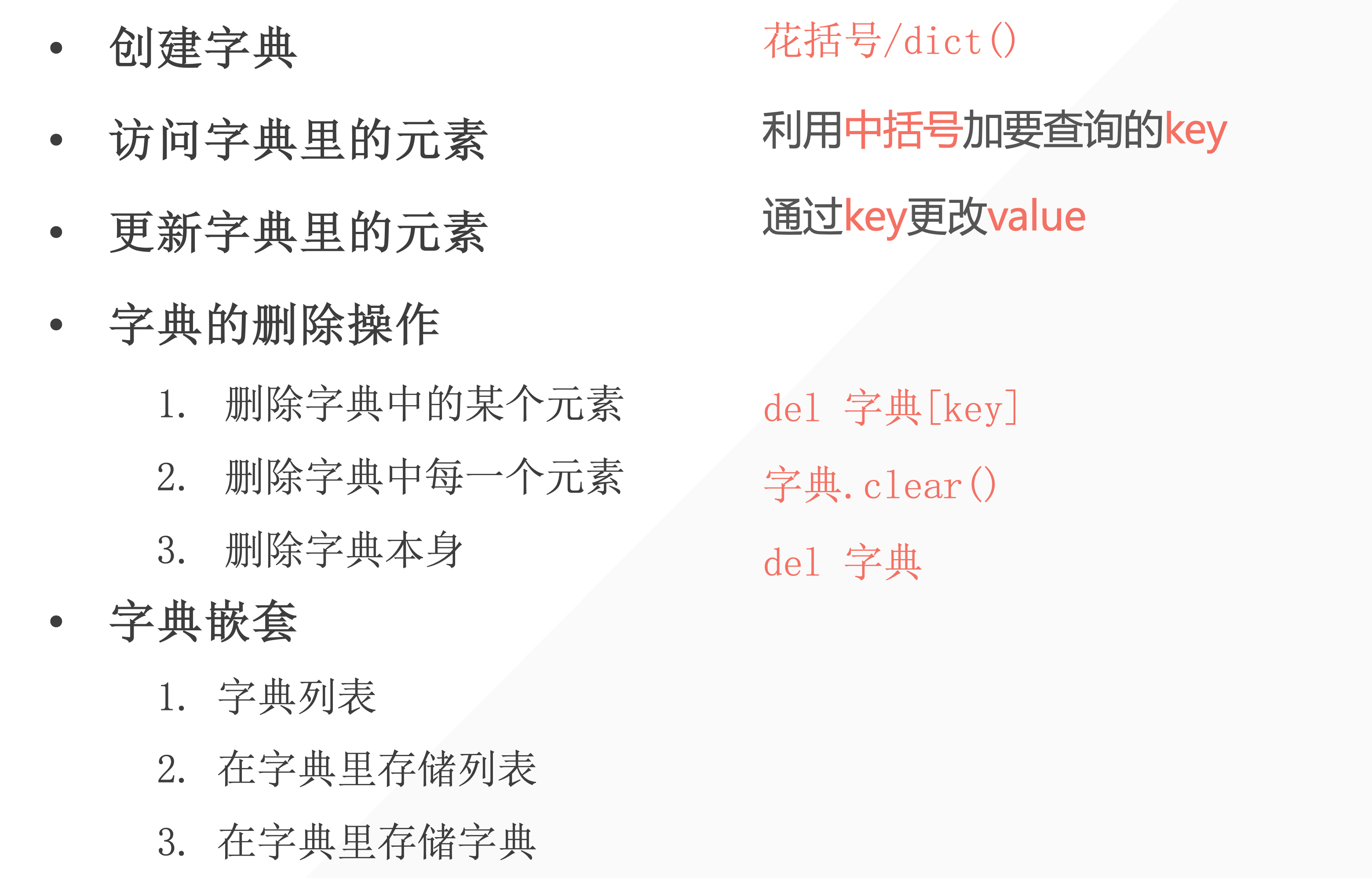dictionary
1. 如何创建一个电话簿
我们现在有以下联系人:
| 姓名 | 手机号 |
|---|---|
| 李雷 | 123456 |
| 韩梅梅 | 132456 |
| 大卫 | 154389 |
| Mr.Liu | 131452 |
| Bornforthis | 180595 |
| Alexa | 131559 |
如何用以往学过的知识构建一个具有用户输入查询功能的电话簿。
变量、数字型、列表、元组、字符串。
程序运行效果:
- 测试一:
Enter your search name: 李雷
The 李雷 phone number is: 123456
- 测试二:
Enter your search name: Bornforthis
The Bornforthis phone number is: 180595
contacts = ['李雷', 123456, '韩梅梅', 132456, '大卫', 154389, 'Mr. Liu', 131452, 'Bornforthis', 180595, 'Alexa', 131559]
name = input('Enter your search name:>>> ')
name_index = contacts.index(name)
print(f"{name}'s phone number is {contacts[name_index+1]}")
contacts_name = ['李雷', '韩梅梅', '大卫', 'Mr. Liu', 'Bornforthis', 'Alexa']
contacts_number = [123456, 132456, 154389, 131452, 180595, 131559]
contacts = list(zip(contacts_name, contacts_number))
name = input('Enter your search name:>>> ')
name_index = contacts_name.index(name)
print(f"{name}'s phone number is {contacts[name_index][1]}")
print(f"{name}'s phone number is {contacts_number[name_index]}")
由上面的问题应该要了解两个点:
- 如何用已有的知识去完成未知的新任务,毕竟不可能包含全部各种需求所需要的数据类型类型;
- 字典存在意义,从上面题目完成后应该要 get 到。
2. 字典结构
- 用 花括号 表示字典
- 字典内每一项都有两个元素组成:key 和 value
{key: value, key: value}
- 各个项用 逗号 隔开
phone_numbers = {'lilei': 1234, 'hanmeimei': 3456, 'madongmei': 1123}
print(phone_numbers['lilei']) # 提取某个value用[key]
# output
1234
3. 字典结构 key&value
- key 和 value 是一一对应,同一个键只能有一个对应的值
- 键的类型是不可变的;str/
- value 的类型是任意的;
phone_numbers = {'lilei': 1234, 'hanmeimei': 3456, 'madongmei': 1123, True :'bool', 2:'int' }
print(phone_numbers)
# output
{'lilei': 1234, 'hanmeimei': 3456, 'madongmei': 1123, True: 'bool', 2: 'int'}
- 如果key用列表则会报错
phone_numbers = {'lilei': 1234, ['hanmeimei']: 3456, 'madongmei': 1123, True :'bool', 2:'int' }
print(phone_numbers)
# output
Traceback (most recent call last):
File "/Users/gaxa/Coder/Pythonfile/data_type.py", line 1, in <module>
phone_numbers = {'lilei': 1234, ['hanmeimei']: 3456, 'madongmei': 1123, True :'bool', 2:'int' }
^^^^^^^^^^^^^^^^^^^^^^^^^^^^^^^^^^^^^^^^^^^^^^^^^^^^^^^^^^^^^^^^^^^^^^^^^^^^^^^
TypeError: unhashable type: 'list'
4. 用字典dict函数创建字典
- 方法一:根据其他序列新建字典
message = [('lilei', 98), ('hanmeimei', 99)]
list_to_dict = dict(message) # 把元组中1号位都变成value
print(list_to_dict)
# output
{'lilei': 98, 'hanmeimei': 99}
- 方法二:根据关键字参数新建字典
d = dict(lilei=98, hanmeimei=99)
print(d)
# output
{'lilei': 98, 'hanmeimei': 99}
上面两种创建字典的方法,有什么优缺点?
上面方法一的方法,可以更好的适配字典的各种数据类型情况。why?——因为结构是列表里面放元组,而元组的 0 号位放 key,1 号位放 value。所以,只要是不可变的数据类型都可以放在 0 号位。
反之对比上面方法二:第一个位置必须是“变量”,不能是其它数据类型。举个例子:
d = dict(lilei=98, hanmeimei=99) # 看起来正常 lilei是变量
d = dict('lilei'=98, 'hanmeimei'=99) # 看起来怎么样?‘lilei’是value
File "/Users/gaxa/Coder/Pythonfile/data_type.py", line 1
d = dict('lilei'=98, hanmeimei=99)
^^^^^^^^
SyntaxError: expression cannot contain assignment, perhaps you meant "=="?
# value 不能被赋值为另一个 value,value之间只能用 ==
上面第二行代码,看起来就很奇怪了,一共有两个值一个值是 'lilei' 另一个值 98 两个都是值,可以用 98 赋值给另一个值吗?——显然是不行的。我们的赋值是需要把一个值赋值给一个变量「有空间」。
所以,第二种方法虽然可以实现创建字典,但是对于字典 key 的各种情况并不能完全支持。
output时 第二种的 key 只会是字符串
5. 访问字典的数据
5.1 用中括号访问
- 利用中括号加要查询的 key
grade = {'lilei': 98, 'hanmeimei': 99}
print(grade['hanmeimei'])
5.2 上面的提取方法存在的问题
在提取不存在的key时会报错
grade = {'lilei': 98, 'hanmeimei': 99}
print(grade['ma'])
# output
Traceback (most recent call last):
File "/Users/gaxa/Coder/Pythonfile/data_type.py", line 2, in <module>
print(grade['ma'])
~~~~~^^^^^^
KeyError: 'ma'
就像我们查询电话簿的时候,没找到会返回:未找到。

5.3 使用.get()解决
当使用 get 方法时,需要提供一个键(key),方法会返回与该键关联的值。如果该键在字典中不存在,get 方法将返回 None,或者你可以指定一个默认值,如果键不存在,则返回这个默认值。
这是 get 方法的基本语法:
value = dictionary.get(key, default_value)
key:你想要检索的键。default_value:(可选)如果键不存在时返回的值。如果未提供此参数,默认值为None。
下面是一个使用 get 方法的例子:
grade = {'lilei': 98, 'hanmeimei': 99}
print(grade.get("lilei"))
print(grade.get("ma")) # 如果key不存在则会返回默认值None
# 如果单独设定在 key 不存在时所指定的返回内容
print(grade.get("ma", "Not specified"))
# output
98
None
Not specified
在第一个 get 调用中,我们访问了键 'name',它在字典中存在,因此返回了对应的值 98。在第二个调用中,我们试图访问键 'ma',它在字典中不存在,因此返回了我们指定的默认值 'Not Specified'。
6. 更新字典的数据
字典修改或添加数据原则:有则改之,无则加勉「无则添加」

grade = {'lilei': 98, 'hanmeimei': 99}
grade['lilei'] = 95
grade['madongmei'] = 100
print(grade)
# output
{'lilei': 95, 'hanmeimei': 99, 'madongmei': 100}
7. 字典数据删除

grade = {'A': 98, "B": 99, "C": 95}
print(grade)
del grade['A']
print(grade)
# output
{'A': 98, 'B': 99, 'C': 95}
{'B': 99, 'C': 95}
grade.clear()
print(grade)
# output
{}
del grade # the variable would be deleted hence not able to print
print(grade)
# output
Traceback (most recent call last):
File "/Users/gaxa/Library/Containers/com.tencent.xinWeChat/Data/Library/Application Support/com.tencent.xinWeChat/2.0b4.0.9/c6f75b68835a096ebee7933989e7770c/Message/MessageTemp/4b975e58c46c58ce379c1852275bb5cf/File/python.py", line 10, in <module>
print(grade)
^^^^^
NameError: name 'grade' is not defined
8. 字典结构嵌套字典
嵌套:将一系列字典存储在列表中,或将列表作为值存储在字典中。
- 字典列表
- 在字典中存储列表
- 在字典中存储字典
8.1 字典列表
student1 = {'name': "A", "age": 18, "grade": 98}
student2 = {'name': "B", "age": 19, "grade": 99}
student3 = {'name': "C", "age": 18, "grade": 95}
students = [student1, student2, student3]
print(students)
print(students[2]["grade"])
print(students[2].get("grade"))
小试牛刀:通过提取 students 来得到 韩梅梅的分数
print(students[2]['grade'])
print(students[2].get('grade'))
中括号和 get 的选择依据:看数据是否是确定的,如果是确定的优先使用中括号提取。否则,使用 get。
::::
8.2 在字典中存储列表
favorite_class = {
'A': ["math", "english"],
'B': ["chinese"],
'C': ["computer science", "physics", "math"]
}
print(favorite_class["C"][2])
# output
math
8.3 在字典中存储字典
student1 = {"name": 'A', "grade": 98, "实验班": True}
student2 = {"name": 'B', "grade": 95, "实验班": True}
student3 = {"name": 'C', "grade": 89, "实验班": False}
class1 = {"A": student1, "B": student2, "C": student3}
print(class1)
print(class1["C"]["实验班"])
# output
False
9. 字典常见方法
9.1 .pop(key)
删除特定的键对值
student1 = {"name": 'A', "grade": 98, "实验班": True}
student1.pop("实验班")
print(student1)
# output
{'name': 'A', 'grade': 98}
9.2 .keys()
获取字典中的所有键
student1 = {"name": 'A', "grade": 98, "实验班": True}
keys = student1.keys()
print(keys)
print(list(keys))
# output
dict_keys(['name', 'grade', '实验班'])
['name', 'grade', '实验班']
9.3 .values()
获取字典中的所有值
student1 = {"name": 'A', "grade": 98, "实验班": True}
values = student1.values()
print(values)
print(list(values))
# output
dict_values(['A', 98, True])
['A', 98, True]
9.4 .items()
获取字典的键对值,以tuple的形式
student1 = {"name": 'A', "grade": 98, "实验班": True}
values = student1.items()
print(values)
print(list(values))
# output
dict_items([('name', 'A'), ('grade', 98), ('实验班', True)])
[('name', 'A'), ('grade', 98), ('实验班', True)]
9.5 in
- 默认情况是判断key在字典中
student1 = {"name": 'A', "grade": 98, "实验班": True}
print("name" in student1)
True
- 使用keys实现纯粹判断
student1 = {"name": 'A', "grade": 98, "实验班": True}
print("name" in student1.keys())
True
- 使用values实现纯粹判断
student1 = {"name": 'A', "grade": 98, "实验班": True}
print("name" in student1.values())
False

 0
0 0
0 0
0 0
0 0
0 0
0
